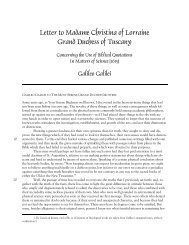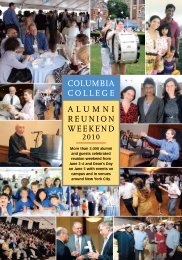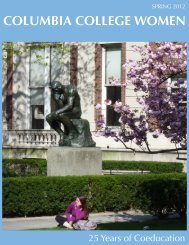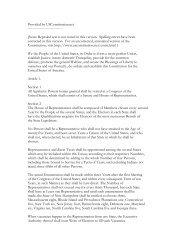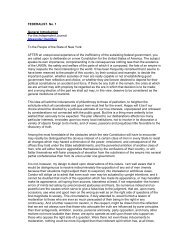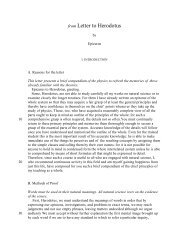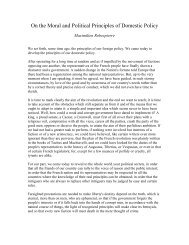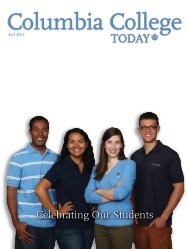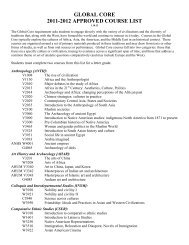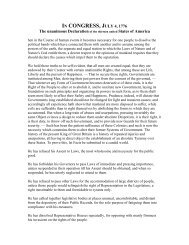Download this issue as a PDF - Columbia College - Columbia ...
Download this issue as a PDF - Columbia College - Columbia ...
Download this issue as a PDF - Columbia College - Columbia ...
Create successful ePaper yourself
Turn your PDF publications into a flip-book with our unique Google optimized e-Paper software.
COLUMBIA COLLEGE TODAY<br />
COLUMBIA COLLEGE TODAY<br />
CLASSIC READINGS, MODERN TECHNOLOGY<br />
Students and Faculty<br />
Embrace Cl<strong>as</strong>sic Readings,<br />
Modern Technology<br />
“The course is not a museum-like visit.<br />
It’s about the interrogation of texts.”<br />
The origins of Humanities A — <strong>as</strong> Lit Hum w<strong>as</strong> called originally<br />
— go back to the first days of the Core Curriculum. Emboldened<br />
by a successful experiment with a “war <strong>issue</strong>s” course<br />
during WWI, in 1919 the <strong>College</strong> launched Introduction to Contemporary<br />
Civilization in the West. A year later Professor of English<br />
John Erskine (Cl<strong>as</strong>s of 1900), who had championed a “liberal”<br />
education against those who wanted more pre-professional training<br />
at the <strong>College</strong>, began his General Honors seminar, co-taught<br />
by two professors. This course, spread out across the junior and<br />
senior years, featured one “great book” per cl<strong>as</strong>s, which w<strong>as</strong> read<br />
in translation and discussed in small sections.<br />
B y T i m ot h y P. Cross ’98 GSAS<br />
Literature Humanities can be described in many ways: ambitious, provocative,<br />
imposing, eye-opening. It is the first cl<strong>as</strong>s that freshmen encounter —<br />
embodied in the gift copy of The Iliad they receive during the summer from<br />
the <strong>Columbia</strong> <strong>College</strong> Alumni Association — and a formative experience,<br />
one whose influence extends well beyond the cl<strong>as</strong>sroom. Its teaching methods<br />
have expanded with technology, and its texts and the conversations surrounding<br />
them have evolved with attitudes. Indeed, after 75 years, what may be most remarkable<br />
about Lit Hum is how what began <strong>as</strong> an effort to buck the academic establishment h<strong>as</strong><br />
proven itself an adaptable and indispensable pillar of the <strong>Columbia</strong> <strong>College</strong> experience.<br />
Erskine saw <strong>this</strong> effort <strong>as</strong> a remedy for what he and his colleagues<br />
perceived <strong>as</strong> “the literary ignorance of the younger generation.”<br />
But what w<strong>as</strong> truly innovative w<strong>as</strong> his approach, reading<br />
“The Iliad, The Odyssey and other m<strong>as</strong>terpieces <strong>as</strong> though they<br />
were recent publications, calling for immediate investigation and<br />
discussion.” As much <strong>as</strong> it horrified some colleagues — especially<br />
those enamored of German-style instruction that emph<strong>as</strong>ized<br />
memorization and rote learning — Erskine’s approach caught on,<br />
though its impact w<strong>as</strong> limited to those students enrolled in the<br />
General Honors seminar.<br />
Erskine w<strong>as</strong>, and remains, a controversial figure in <strong>Columbia</strong>’s<br />
Gareth Williams, the Violin Family Professor of Cl<strong>as</strong>sics and chair of Lit Hum, says that to read the course’s texts “is to introduce yourself<br />
to being unsettled about life.”<br />
PHOTO: MICHAEL DiVITO<br />
history. Charismatic, attention-grabbing and attention-seeking,<br />
he always had ambitions that went beyond being a college professor,<br />
including writing music, poetry and fiction. As his biographer<br />
Katherine Elise Chaddock h<strong>as</strong> observed, Erskine became<br />
America’s first “celebrity professor,” recognized <strong>as</strong> much for<br />
his potboiler novels — such <strong>as</strong> The Private Life of Helen of Troy<br />
(1925), which w<strong>as</strong> made into a silent film — <strong>as</strong> for his educational<br />
achievements. These began pulling him away from <strong>Columbia</strong>,<br />
and by the late 1920s, when the <strong>College</strong> decided<br />
to require a second semester of Contemporary<br />
Civilization and abandon the General<br />
Honors course, Erskine w<strong>as</strong> largely out of the<br />
picture.<br />
But the seed Erskine planted had already<br />
taken root. In a few years, a handful of the <strong>College</strong>’s<br />
professors — including Jacques Barzun<br />
’27, ’32 GSAS, Irwin Edman (Cl<strong>as</strong>s of 1916,<br />
Cl<strong>as</strong>s of 1920 GSAS) and Raymond Weaver<br />
(Cl<strong>as</strong>s of 1910, Cl<strong>as</strong>s of 1917 GSAS), who had<br />
been Erskine’s students — resurrected the<br />
General Honors course <strong>as</strong> the Colloquium in<br />
Important Books. The colloquium, which adopted<br />
both the scope and format of the General<br />
Honors course, w<strong>as</strong> taught regularly, then sporadically,<br />
for decades.<br />
More importantly, it planted the idea in<br />
some of the same faculty’s minds that <strong>this</strong> sort<br />
of course might be appropriate for all undergraduates,<br />
not just a select few who decided<br />
The seminar format, with no more<br />
than 22 students per cl<strong>as</strong>s, is vital to<br />
Lit Hum’s success.<br />
PHOTO: MATTHEW SEPTIMUS<br />
to enroll <strong>as</strong> juniors and seniors. Here the success of Literature<br />
Humanities’ older sibling, Contemporary Civilization, proved<br />
crucial. If the <strong>College</strong>’s freshmen could handle close reading and<br />
discussion in a small cl<strong>as</strong>s format for CC, why not for literature<br />
The first <strong>College</strong> faculty meetings to draft a humanities<br />
course convened in 1934. The plan w<strong>as</strong> to have a two-year humanities<br />
sequence in which undergraduates would confront literature,<br />
art and music, but difficulties in integrating music and<br />
art proved too much at first. Music Humanities<br />
and Art Humanities (together originally<br />
called Humanities B) became electives, but in<br />
fall 1937, the <strong>College</strong> introduced Humanities<br />
A <strong>as</strong> a new Core requirement.<br />
In many ways, it’s striking how much of<br />
Erskine’s original vision lives on in today’s<br />
Literature Humanities. Cl<strong>as</strong>ses generally<br />
still read one text per week, in translation.<br />
Students then discuss these texts in small sections,<br />
though there are a lot more of those sections<br />
now — about 65 — compared with only<br />
20 when the course w<strong>as</strong> created.<br />
This format matters. “A student having<br />
book in hand each week makes a difference<br />
in conversation,” says Christia Mercer, the<br />
Gustave M. Berne Professor of Philosophy, a<br />
former Lit Hum chair who will resume the<br />
post <strong>this</strong> fall. That’s why Lit Hum h<strong>as</strong> never<br />
even flirted with the idea of creating readers,<br />
SPRING 2013<br />
18<br />
SPRING 2013<br />
19




